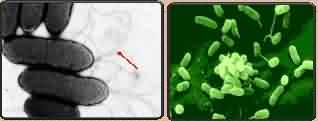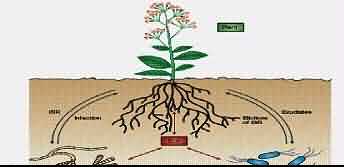स्यूडोमोनास फल्योरेसेन्स की फफूंद रोगाणुओं केे जैव नियंत्रण की क्षमता।
Plant diseases cause 13 - 20 % losses in crop production worldwide. Control of plant disease by chemical can be spectacular but the accumulation of harmful chemical residue sometimes causes serious ecological problems. Biocontrol agents are economical, suppress the inoculum load of the target pathogen, long lasting and free from residual side effect. Fungi in the genus Trichoderma and Bacteria in the genera of Pseudomonas and Bacillus are increasing interest as bioprotectants against plant diseases. Biocontrol agents in general and Pseudomonas fluorescens in particularhave gained importance as a component of Integrated Pest Management for sustainable agriculture (Mukhopadhyay, 1987). Pseudomonas fluorescens belong to Plant Growth Promoting Rhizobacteria (PGPR), the important group of bacteria that play a major role in the plant growth promotion, induced systemic resistance, biological control of plant pathogens etc.
P. fluorescens as biocontrol agent:
The bacteria P. fluorescens possess many traits that make them well suited as biocontrol and growth-promoting agents.These include the ability to-
- Grow rapidly in vitro and to be mass produced.
- Rapidly utilize seed and root exudates.
- Colonize and multiply in the rhizosphere and spermosphere environments and in the interior of the plants.
- Produce a wide spectrum of bioactive metabolites.
- Compete aggressively with other microorganisms.
- Adapt to environmental stresses and,
- Inexpensive
Isolation and identification:
- Collect rhizosphere soil particles loosely adhering to the roots and make fine powder.
- Add 10 gm sample of finely pulverized, air dried soil into 90 ml sterilized distill water to make 1:10 dilution (10-1).
- Vigorously shake the dilution on a magnetic shaker for 20-30 minutes to obtain uniform suspension.
- Transfer 1 ml of suspension (1:10 dilution) to another 9 ml sterilized distill water to make 1:100 dilution(10-2).
- Prepare serial dilution 10-3 to 10-7 as outlined earlier.
- Use King’s B medium for isolation of P. fluorescens.
- Pour 20 ml sterilized, melted and cooled (450 C) King’s B medium in each Petri plate.
- Transfer 1 ml of soil suspension from aliquot dilution (10-5 to 10-7) to sterilized Petri plates containing King’s B medium.
- Incubate Petri plates at 28 + 20C for 24 hours.
- Detect and mark individual colonies with yellow-green and blue white pigments by viewing under UV light.
- Pick up individual colony with sterilized loop and transfer on to fresh king’s B medium.
- Transfer single colonies to King’s B medium slants to obtain pure culture and store in refrigerator at 40C.
Morphological and Biochemical characteristics:
- Cells are single, straight or curved but not helical.
- Cells are generally 0.7-0.8 X 2.3- 2.8 micron in size during expontial growth.
- Motile with polar multitrichous flagellation.
- Gram negative.
- Strict aerobes, chemoorganotrophs, metabolism respiratory, never fermentative.
- Culture produces diffusible fluorescent (yellow-green) pigment on King’s B medium.
- Optimum temperature for growth ranges from 25-30o C.
The P. fluorescens shows positive reaction to Gelatin liquefaction, Catalase test, Oxidase test, Starch hydrolysis, Levan formation from sucrose, Citrate utilization etc.

Mode of action:
- Antibiotic Production
- Siderophores Production
- Induced Systemic Resistance
- Competition
- Hydrogen Cynide Production
- Plant Growth Promotion Antibiotic Production
1. Antibiotic Production:
The P. fluorescens is very effective antibiotic producer.Many secondary metabolites of P. fluorescens acts as antibiotics against plant pathogens. The P. fluorescens produces antifungal compounds which are fungistatic, inhibiting spore germination and lysis of fungal mycelia.
- Phenazine-1-Carboxylic Acid (PCA)
- 2, 4 – Diacetylphloroglucinol (DAPG)
- Pyocinine
- Pyrrolnitrin
- Pyoluteorin
- Oomycin-A
2. Siderophores Production:
Siderophores are extra cellular, low-molecular weight compounds with very high affinity for ferric iron. As siderophore sequester the limited supply of iron in the rhizosphere, they limits it’s availability to pathogens and ultimately suppress their growth.
- Ferribactin
- Ferrichrome
- Ferroxamine B
- Pseudobactin
- Pyochelin
- Pyoverdine
3. Induced Systemic Resistance:
The P. fluorescens induce systemic resistance in plants that is phenotypically similar to Systemic Acquired Resistance (SAR). Induction of resistance by P. fluorescens is mainly through the:
- Production of phytoalexins,
- Increased lignifications
- Production of PR-protein in the induced plants

4. Competition:
The P. fluorescens preempt the establishment of other rhizosphere microorganisms through competition for favored sites on the roots and in the rhizosphere.
5. Hydrogen cynide production:
Hydrogen cynide (HCN) is representative of class of volatile inhibitors. The P. fluorescens produces HCN which can check growth of phytopathogen although the producer bacterium itself resistance
6. Plant Growth Promotion Antibiotic Production:
The P. fluorescens promotes plant growth by prodution of phytohormones such as Auxins and Gibberrelins and also by Phosphate solubilization.
Mass multiplication and formulation:
- Mass multiply P. fluorescens on sterilized King’s B browth for 48 hours at 25 + 20C.
- Adjust pH of substrate (eg. Talc powder) used for formulation to 7.0 by adding calcium carbonate
- Add carboxy methyl cellulose in substrate @ 10g / kg.
- Autoclave –sterilize the mixture for 30 min in two consecutive days.
- Add 400 ml of P. fluorescens culture (Containing 9 X 108 cfu/ml) per kg of the mixture and mix well under sterilize condition.
- Dried the product under shade to bring the moisture content to less than 20 per cent.
- Pack formulated products in milky white coloured polythene bags, sealed and kept under room temperature.
- Fresh product should contain 3 X 108 cfu/gm of P. fluorescens.
Authors: Mahaveer Singh Bachaya, Parsant Chauhan and Manoj Kumar Jat*Department of Plant PathologyCollege of Agriculture, CCS, Haryana Agricultural University, Hisar (Haryana)*Department of Entomoogy
